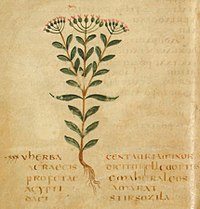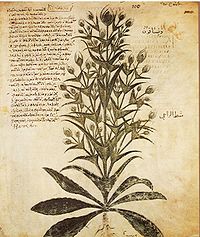List of Dacian plant names
Appearance
This article needs additional citations for verification. (March 2023) |


This is a list of plant names in Dacian, surviving from ancient botanical works such as Dioscorides' De Materia Medica (abb. MM) and Pseudo-Apuleius' Herbarius (abb. Herb.). Dacian plant names are one of the primary sources left to us for studying the Dacian language, an ancient language of South Eastern Europe. This list also includes a Bessian plant name and a Moesian plant name, both neighboring Daco-Thracian tribes, as well as a clear Albanoid name. According to linguist Vladimir I. Georgiev, the suffixes -dela, -dil(l)a, -zila and -tilia indicate names of medicinal plants.[1]
| Dacian | English | Botanical | Notes |
|---|---|---|---|
| Adila |
|
Per Georgiev, from *aydʰ-ilo 'burning' > 'red'.[2] | |
| Amalusta, Amolusta [5], Amulusta | Chamomile | Matricaria recutita or Anthemis tinctoria | ^ Herb. 23; possibly related to Albanian ëmbël, ambël "sweet".[3] *lustu appears as a proto-Celtic word for "plant".[4] |
| Aniarsexe, Aniassexie | Sainfoin a.k.a. Cock's Head | Onobrychis caput galii | |
| Aprus | Gladwin Iris | Iris foetidissima | |
| Arpopria, Arborria | Climbing Ivy | Hedera helix | |
| Asa | Coltsfoot | Tussilago farfara | also a Bessian plant name. |
| Aurumetti, Aurimetellum | Cranesbill a.k.a. Crow's Foot, Wild Geranium ? | Geranium sylvaticum or Ranunculus serdous? | MM 2.175, Herb. 67 |
| Azila | Hound's Tongue | Cynoglossum | Probably a variant of Usazila (see below) |
| Bles, Blis | Purple Amaranth | Amaranthus blitum | |
| Budalla, Budama, Budathala, Budathla | Anchusa | Anchusa italica | Per Georgiev, Boudathla corresponds to bou-glosson 'ox's tongue'; from *gʷṓw-dn̥ǵʰ(w-e)lä 'ox-tongue'.[5] |
| Caropithla, Karopithla |
|
||
| Cercer, Cerceraphron, Kerker, Kerkeraphron | Pimpernel | Anagallis | |
| Chodela, Khodela | Ground Pine | Lycopodium (Lycopodium clavatum or Lycopodium annotitum / Lycopodium dubium?) | |
| Cinouboila, Cinuboila, Kinouboila, Kinuboila | a compound of kinu "dog" and oboila "apple", akin to Lithuanian šúnobuolas "wild pumpkin", Thracian dinupula, sinupyla "id". Per Georgiev, literally "hound's apple".[6] | ||
| Coadama, Koadama | Pondweed[7] | Potamogeton zosteraefolium | |
| Coicolida, Koikolida | Nightshade | Atropa belladonna | the first element koiko means "one-eyed" or "blind", and is akin to Latin caecus "blind", Irish caoch "one-eyed", Goth haihs "one-eyed", Sanskrit kekara "squint-eyed" |
| Cotiata, Kotiata | Switchgrass | Panicum dactylum | also refers to genus Agropyron? |
| Courionnecum, Couriounnecum, Curiounnecum, Kourionnekoum | Arum | Arum | |
| Coustane, Croustane, Crustane, Custane, Koustane, Kroustane, Krustane, Kustane | Greater celandine or Lesser celandine | Chelidonium majus or Ranunculus ficaria | |
| Cycolis, Kykolis | Groundcherry or Ashwagandha | Physalis sp. or Withania somnifera | |
| Dacina, Dakina |
|
the Moesian name for these plants was Mendruta (see below) | |
| Dicotella | White Bryony | Bryonia alba | |
| Diellina, Dielina, Dielleina, Diellena | Henbane | Hyoscyamus niger | a Proto-Albanoid term, with a clear etymological connection to Albanian dielli ("sun") < PAlb. *dðiella < *dziella- < EPAlb. *ȷ́élu̯a- < PIE *ǵʰélh₃u̯o- "yellow, golden, bright/shiny".[8] |
| Diesapter | Mullein | Verbascum | Georgiev argued that the word contains the stem *dies 'light, day', also present in Diesema.[9] |
| Diessathel | Wavyleaf Mullein | Verbascum sinuatum | from IE *diwes-sētlo; where the second element meant "sieve" (cf. Old Norse sáld "sieve", Welsh hidl "strainer", Lithuanian sėkla "seed", Greek ēthein "to strain", Old Church Slavonic sito)[10] |
| Diesema | Mullein | Verbascum | from IE *diyes eusmn. "burning sky" (cf. Latin dies "day", Greek heúein "to burn") and similar to German Himmelbrand "mullein", literally "burning heavens".[11] |
| Diodela, Duodela, Duodella, Ziodela | |||
| Dracontos | Rosemary | Rosmarinus officinalis | |
| Dokela | Bugle | Ajuga iva | |
| Dyn | Nettle | Urtica | |
| Ebustrone | Lesser celandine | Ranunculus ficaria | From Pseudo-Apuleis |
| Gonoleta, Gouoleta, Guoleta, Guolete | Gromwell[12] | Lithospermum tenuiflorum | Consumed as an oral contraceptive |
| Hormea, Hormia | Annual Clary | Salvia horminum | |
| Lax | Purslane | Portulaca oleracea | Used as a laxative |
| Manteia, Mantia | Woolly Blackberry | Rubus tomentosus | related to Albanian man "mulberry"[13] |
| Mendruta | Actually, a Moesian plant name | ||
| Mizela, Mizila, Mozula, Mouzula | Thyme | Thymus | |
| Nemenepsa | Ground Pine | Lycopodium | |
| Olma | Dwarf elder, Danewort | Sambucus ebulus | |
| Parithia, Parthia | Dog's Tooth Grass | Cynodon ? | |
| Pegrina | White Bryony | Bryonia alba | |
| Phithophthethela | Maidenhair fern | Adiantum | |
| Polpum | Dill | Anethum graveolens | |
| Priadela, Priadila | White Bryony or Black Bryony | Bryonia alba or Tamus communis | |
| Probedula, Procedila [6], Propedila, Propedula, Propodila | Creeping Cinquefoil | Potentilla reptans | ^ Procedila< Prokedila, probably a scribal error for *Probedila, a graphic confusion between β/κ being rather common in Greek manuscripts. Compare to the Gaulish name for this plant, Pempedula (five-leaved). |
| Prodiarna, Prodiorna | Black Hellebore | Helleborus niger | |
| Rathibida | Italian Aster | Aster amellus | |
| Riborasta | Burdock | Arctium | |
| Salia | |||
| Seba | Elderberry | Sambucus | Georgiev equated it to Lithuanian šeivà.[14] |
| Skiare | Wild Teasel | Dipsacus sylvestris or Dipsacus fullonum | |
| Skinpoax, Sipoax, Spioax | Broadleaf Plantain | Plantago major | |
| Sikupnoex, Sikupnux | Eryngo | Eryngium campestre | |
| Stirsozila | Centaury | Centaurium erythraea, formerly classified as Erythraea centaurium | from Pseudo-Apuleis |
| Tanidila | Catmint | Nepeta | |
| Teudila | Peppermint or Horsemint or Calamint? | Mentha x piperita or Mentha sylvestris or Calamintha? | |
| Troutrastra, Trutrastra, Tutrastra | |||
| Toulbela, Tulbela | Centaury | Centaurium erythraea | |
| Usazila | Hound's Tongue | Cynoglossum | Probably a variant of Azila (see above) |
| Zena | Poison Hemlock | Conium maculatum | |
| Zired | Redstem Wormwood | Artemisia scoparia | |
| Zououster, Zuste, Zuuster | Wormwood | Artemisia arborescens or campestris |
See also
[edit]- Dacian language
- List of Dacian words
- List of Romanian words of possible pre-Roman origin
- List of Dacian names
References
[edit]- ^ Georgiev, Vladimir I.. "Thrakisch und Dakisch". Band 29/2. Teilband Sprache und Literatur (Sprachen und Schriften [Forts.]), edited by Wolfgang Haase, Berlin, Boston: De Gruyter, 1983. p. 1180. doi:10.1515/9783110847031-015
- ^ Georgiev, Vladimir I.. "Thrakisch und Dakisch". Band 29/2. Teilband Sprache und Literatur (Sprachen und Schriften [Forts.]), edited by Wolfgang Haase, Berlin, Boston: De Gruyter, 1983. p. 1179. doi:10.1515/9783110847031-015
- ^ Malcolm, Noel. Kosovo: A Short History. New York: New York University Press, 1998.
- ^ "Prifysgol Cymru University of Wales; Centre for Advanced Welsh and Celtic Studies; English - proto-Celtic word list" (PDF). Archived (PDF) from the original on 2022-02-05. Retrieved 2009-03-04.
- ^ Georgiev, Vladimir I.. "Thrakisch und Dakisch". Band 29/2. Teilband Sprache und Literatur (Sprachen und Schriften [Forts.]), edited by Wolfgang Haase, Berlin, Boston: De Gruyter, 1983. p. 1179. doi:10.1515/9783110847031-015
- ^ Georgiev, Vladimir I.. "Thrakisch und Dakisch". Band 29/2. Teilband Sprache und Literatur (Sprachen und Schriften [Forts.]), edited by Wolfgang Haase, Berlin, Boston: De Gruyter, 1983. p. 1180. doi:10.1515/9783110847031-015
- ^ Katičic, Radislav. Ancient Languages of the Balkans, Part One. Paris: Mouton, 1976. p. 144. doi:10.1515/9783111568874.128
- ^ Crăciun, Radu (2023). "Diellina, një bimë trako-dake me emër proto-albanoid" [Diellina, a Thracian-Dacian plant with a Proto-Albanoid name]. Studime Filologjike (1–2). Centre of Albanological Studies: 77–83. doi:10.62006/sf.v1i1-2.3089. ISSN 0563-5780.
- ^ Georgiev, Vladimir I.. "Thrakisch und Dakisch". Band 29/2. Teilband Sprache und Literatur (Sprachen und Schriften [Forts.]), edited by Wolfgang Haase, Berlin, Boston: De Gruyter, 1983. p. 1180. doi:10.1515/9783110847031-015
- ^ Orel, Vladimir E. A Handbook of Germanic Etymology. Brill, 1998.
- ^ Katičic, Radislav. Ancient Languages of the Balkans, Part One. Paris: Mouton, 1976. p. 149. doi:10.1515/9783111568874.128
- ^ Katičic, Radislav. Ancient Languages of the Balkans, Part One. Paris: Mouton, 1976. p. 144. doi:10.1515/9783111568874.128
- ^ Rusakov, Alexander (2017). "Albanian". In Mate Kapović (ed.). The Indo-European Languages (2nd ed.). Routledge. p. 556. ISBN 978-1-315-67855-9.
- ^ Georgiev, Vladimir I.. "Thrakisch und Dakisch". Band 29/2. Teilband Sprache und Literatur (Sprachen und Schriften [Forts.]), edited by Wolfgang Haase, Berlin, Boston: De Gruyter, 1983. p. 1180. doi:10.1515/9783110847031-015
External links
[edit]Wikimedia Commons has media related to Dacian and Dacians.
